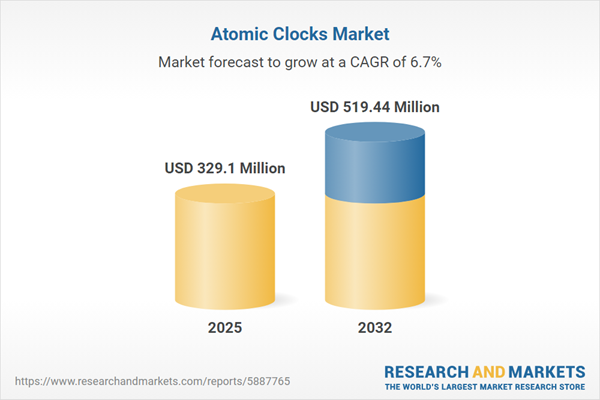Speak directly to the analyst to clarify any post sales queries you may have.
Atomic clocks are redefining global operational standards by enabling ultra-precise time synchronization and supporting essential digital and industrial workflows. As industries intensify their focus on security, reliability, and future-ready infrastructure, the atomic clocks market emerges as a pivotal driver for sustainable business leadership.
Market Snapshot: Atomic Clocks Market Growth
The atomic clocks market is in a period of robust expansion, with a valuation rising from USD 309.69 million in 2024 to USD 329.10 million in 2025. Projected to achieve USD 519.44 million by 2032 at a compound annual growth rate (CAGR) of 6.67%, this growth trajectory is fueled by rapid advances in synchronization capabilities, smaller form factors making devices more versatile, and surging demand for dependable timing accuracy. The sector, once limited to laboratories, now underpins critical infrastructure in telecommunications, satellite navigation, and various industrial sectors, setting a high benchmark for performance and operational security.
Scope & Segmentation of the Atomic Clocks Market
- Type: Cesium, hydrogen maser, and rubidium solutions provide precise timing for research institutions, heavy industries, and advancements in autonomous technologies.
- Technology: Cryogenic cooling, double resonance, and quantum clock mechanisms enhance timing precision and resilience, bringing quantum-based synchronization into next-generation system architectures.
- Product: Integrated, portable, and standalone atomic clocks each address specific organizational needs, allowing seamless adaptation across different operational settings, whether centralized or remote.
- Component: Oscillators, quartz crystals, ceramic resonators, and silicon resonators are relied upon in high-stakes environments to extend accuracy, device life, and operational durability.
- Application: Major uses span GPS, scientific research, and telecom networks, enabling essential functions like geolocation, secure time transfer, and robust network timing.
- End-User: Key sectors leveraging these technologies include aerospace, aviation, automotive (including autonomous navigation), consumer electronics, healthcare (notably imaging), research laboratories, and telecommunications. All depend on atomic-level timing for workflow stability and compliance.
- Region: The market’s global scope is led by the Americas, Europe, Middle East & Africa, and Asia-Pacific. The United States, Germany, and Japan advance adoption, while India, South Korea, and Brazil promote tailored deployments to address diverse regional needs.
- Companies Covered: Major innovators and suppliers include AccuBeat Ltd., Microchip Technology Inc., Teledyne Technologies Incorporated, Excelitas Technologies Corp., Trimble Inc., and Safran S.A., ensuring reliable access and continued sector innovation.
Key Takeaways: Strategic Insights for Decision-Makers
- Expansion of quantum and photonic capabilities is making atomic clocks increasingly valuable for sectors requiring advanced timing infrastructure and resilience in distributed operations.
- Progress in device miniaturization supports their deployment in dynamic fields such as aerospace, defense, and mobility, extending secure timekeeping to new and challenging environments.
- Security features, including tamper resistance and cryptographic protocols, are built into systems to address integrity mandates in finance, industrial automation, and blockchain technologies.
- Collaborative efforts between manufacturers, standards bodies, and academic research are streamlining adoption, fostering unified benchmarks, and enabling rapid integration of breakthroughs.
- Regional distinctions are evident, with North America leading in aerospace and core research, Europe advancing telecom infrastructure, and Asia-Pacific integrating timing solutions across high-speed manufacturing and networked mobile systems.
Tariff Impact
Recent U.S. tariff changes have led atomic clock manufacturers to reexamine procurement strategies and focus on optimizing supply chains. Emphasis is shifting toward domestic sourcing and launching localized manufacturing initiatives. By engaging with regional foundries and exploring alternative materials, organizations seek to contain costs, lower risks, and ensure the continuity of advanced timing technology development.
Methodology & Data Sources
This assessment relies on more than thirty interviews with industry specialists, along with thorough analysis of technical documents, regulatory filings, and patent reviews. Insights are reinforced by laboratory validation and expert workshops, delivering a robust foundation for strategic decisions in the atomic clocks market.
Why This Report Matters
- Supports informed procurement and investment, strengthening operational resilience and timekeeping precision in business-critical environments.
- Offers clarity on trends, challenges, and evolving supply needs, equipping leadership teams to manage compliance and anticipate market shifts.
- Delivers data-backed validation for innovation and commercial strategies, instilling confidence for business expansion and future planning.
Conclusion
Adopting new advances in atomic clock technology and strengthening supply chains enhances organizational readiness and efficiency. Unlocking these developments is essential for companies focused on maintaining a responsive and reliable operational advantage.
Additional Product Information:
- Purchase of this report includes 1 year online access with quarterly updates.
- This report can be updated on request. Please contact our Customer Experience team using the Ask a Question widget on our website.
Table of Contents
3. Executive Summary
4. Market Overview
7. Cumulative Impact of Artificial Intelligence 2025
Samples

LOADING...
Companies Mentioned
The key companies profiled in this Atomic Clocks market report include:- AccuBeat Ltd.
- Adtran Networks SE
- AOSense, Inc.
- Bel-Art by SP Scienceware
- Brandywine Communications
- Excelitas Technologies Corp.
- Frequency Electronics, Inc.
- IQD Frequency Products Ltd.
- Leonardo S.p.A.
- Meinberg Funkuhren GmbH & Co KG.
- Microchip Technology Inc.
- Optm, Inc.
- Safran S.A.
- Shanghai Astronomical Observatory
- Stanford Research Systems, Inc.
- Teledyne Technologies Incorporated
- Thermo Fisher Scientific Inc.
- TimeTech GmbH
- Trimble Inc.
- VREMYA-CH JSC
- Zurich Instruments AG
Table Information
| Report Attribute | Details |
|---|---|
| No. of Pages | 182 |
| Published | October 2025 |
| Forecast Period | 2025 - 2032 |
| Estimated Market Value ( USD | $ 329.1 Million |
| Forecasted Market Value ( USD | $ 519.44 Million |
| Compound Annual Growth Rate | 6.6% |
| Regions Covered | Global |
| No. of Companies Mentioned | 22 |








